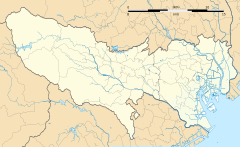Hikarigaoka Station
E38 Hikarigaoka Station 光が丘駅 | |||||||||||
|---|---|---|---|---|---|---|---|---|---|---|---|
 Entrance A2 | |||||||||||
| General information | |||||||||||
| Location | 2-9-5 Hikarigaoka, Nerima City, Tokyo Japan | ||||||||||
| Operated by | |||||||||||
| Line(s) | E Ōedo Line | ||||||||||
| Platforms | 1 island platform | ||||||||||
| Tracks | 2 | ||||||||||
| Connections | |||||||||||
| Construction | |||||||||||
| Structure type | Underground | ||||||||||
| Depth | 11.9 m (39 ft) | ||||||||||
| Other information | |||||||||||
| Station code | E-38 | ||||||||||
| Website | Official website | ||||||||||
| History | |||||||||||
| Opened | 10 December 1991 | ||||||||||
| Passengers | |||||||||||
| FY2011 | 56,529 daily | ||||||||||
| Services | |||||||||||
| |||||||||||
| |||||||||||
Hikarigaoka Station (光が丘駅, Hikarigaoka-eki) is a subway station on the Toei Ōedo Line in Nerima, Tokyo, Japan, operated by Tokyo subway operator Toei Subway.
Lines
[edit]Hikarigaoka Station is the terminus of the Toei Ōedo Line. It is numbered E-38.[1]
Station layout
[edit]The station is the westernmost of all Toei stations, and, at a depth of 11.9 m (39 ft) below ground level, the platform is the closest to the surface of all the Ōedo Line stations.[1] There are five exits from the station, labelled A1 through to A5.[2]
Platforms
[edit]The station has an island platform with two tracks.
| 1 | E Ōedo Line | for Tochōmae, Roppongi, and Daimon |
| 2 | E Ōedo Line | Alighting only |
-
The platforms in January 2022
History
[edit]Hikarigaoka Station opened on 10 December 1991.[3]
Passenger statistics
[edit]In fiscal 2011, the station was used by an average of 56,529 passengers (28,347 boarding, 28,182 exiting) daily.[4] Below is a table of the passenger statistics of the station beginning with 1991, the year the station entered service.
| Year | Passengers | Source |
|---|---|---|
| 1991 | 7,982 | [5] |
| 1992 | 9,019 | [6] |
| 1993 | 10,027 | [7] |
| 1994 | 11,025 | [8] |
| 1995 | 11,303 | [9] |
| 1996 | 11,540 | [10] |
| 1997 | 13,501 | [11] |
| 1998 | 19,545 | [12] |
| 1999 | 20,689 | [13] |
| 2000 | 22,285 | [14] |
| 2001 | 23,975 | [15] |
| 2002 | 25,030 | [16] |
| 2003 | 26,098 | [17] |
| 2004 | 26,668 | [18] |
| 2005 | 27,230 | [19] |
| 2006 | 28,041 | [20] |
| 2007 | 29,251 | [21] |
| 2008 | 29,286 | [22] |
| 2009 | 28,706 | [23] |
| 2010 | 28,468 | [24] |
| 2011 | 28,425 | [25] |
Surrounding area
[edit]The station is located towards the centre of the Hikarigaoka housing complex and is located in the vicinity of the large Hikarigaoka IMA shopping centre.[26] Hikarigaoka itself is located at the northern point of Nerima, Tokyo near the border with Itabashi, Tokyo and Wakō, Saitama. Bus services from this station are operated by Kokusaikōgyō Bus and Seibu Bus.[1] A spur of National Route 443 is routed above the station.[27]
Cultural references
[edit]The station and other parts of the Toei Ōedo Line are referenced in the Digimon Adventure franchise.[28][29][30]
See also
[edit]References
[edit]- ^ a b c "Hikarigaoka". www.kotsu.metro.tokyo.jp. Archived from the original on 12 May 2013. Retrieved 2 August 2013.
- ^ "Hikarigaoka exits". www.kotsu.metro.tokyo.jp. Archived from the original on 3 December 2013. Retrieved 2 August 2013.
- ^ Terada, Hirokazu (19 January 2013). データブック日本の私鉄 [Databook: Japan's Private Railways]. Japan: Neko Publishing. p. 218. ISBN 978-4-7770-1336-4.
- ^ 東京都交通局 各駅乗降人員一覧
- ^ 東京都統計年鑑(平成3年)241ページ
- ^ "東京都統計年鑑(平成4年)". Archived from the original on 15 August 2013. Retrieved 2 August 2013.
- ^ "東京都統計年鑑(平成5年)". Archived from the original on 3 February 2013. Retrieved 2 August 2013.
- ^ "東京都統計年鑑(平成6年)". Archived from the original on 3 February 2013. Retrieved 2 August 2013.
- ^ "東京都統計年鑑(平成7年)". Archived from the original on 3 February 2013. Retrieved 2 August 2013.
- ^ "東京都統計年鑑(平成8年)". Archived from the original on 3 February 2013. Retrieved 2 August 2013.
- ^ "東京都統計年鑑(平成9年)". Archived from the original on 4 March 2016. Retrieved 2 August 2013.
- ^ "東京都統計年鑑(平成10年)" (PDF).
- ^ "東京都統計年鑑(平成11年)" (PDF).
- ^ 東京都統計年鑑(平成12年)
- ^ 東京都統計年鑑(平成13年)
- ^ 東京都統計年鑑(平成14年)
- ^ 東京都統計年鑑(平成15年)
- ^ 東京都統計年鑑(平成16年)
- ^ 東京都統計年鑑(平成17年)
- ^ 東京都統計年鑑(平成18年)
- ^ 東京都統計年鑑(平成19年)
- ^ 東京都統計年鑑(平成20年)
- ^ 東京都統計年鑑(平成21年)
- ^ 東京都統計年鑑(平成22年)
- ^ 東京都統計年鑑(平成23年)
- ^ "Hikarigaoka IMA". IMA Office. Retrieved 2 August 2013.
- ^ "Google Maps". Google Maps. Retrieved 15 December 2015.
- ^ "Odaiba Memorial - Hikarigaoka". Archived from the original on 22 December 2015. Retrieved 14 December 2015.
{{cite web}}: CS1 maint: bot: original URL status unknown (link) - ^ "Odaiba Memorial - Juunigou-sen". Archived from the original on 4 March 2016. Retrieved 15 December 2015.
{{cite web}}: CS1 maint: bot: original URL status unknown (link) - ^ "Odaiba Memorial - Shinjuku". Archived from the original on 22 December 2015. Retrieved 15 December 2015.
{{cite web}}: CS1 maint: bot: original URL status unknown (link)
External links
[edit]- Official website (in Japanese)






